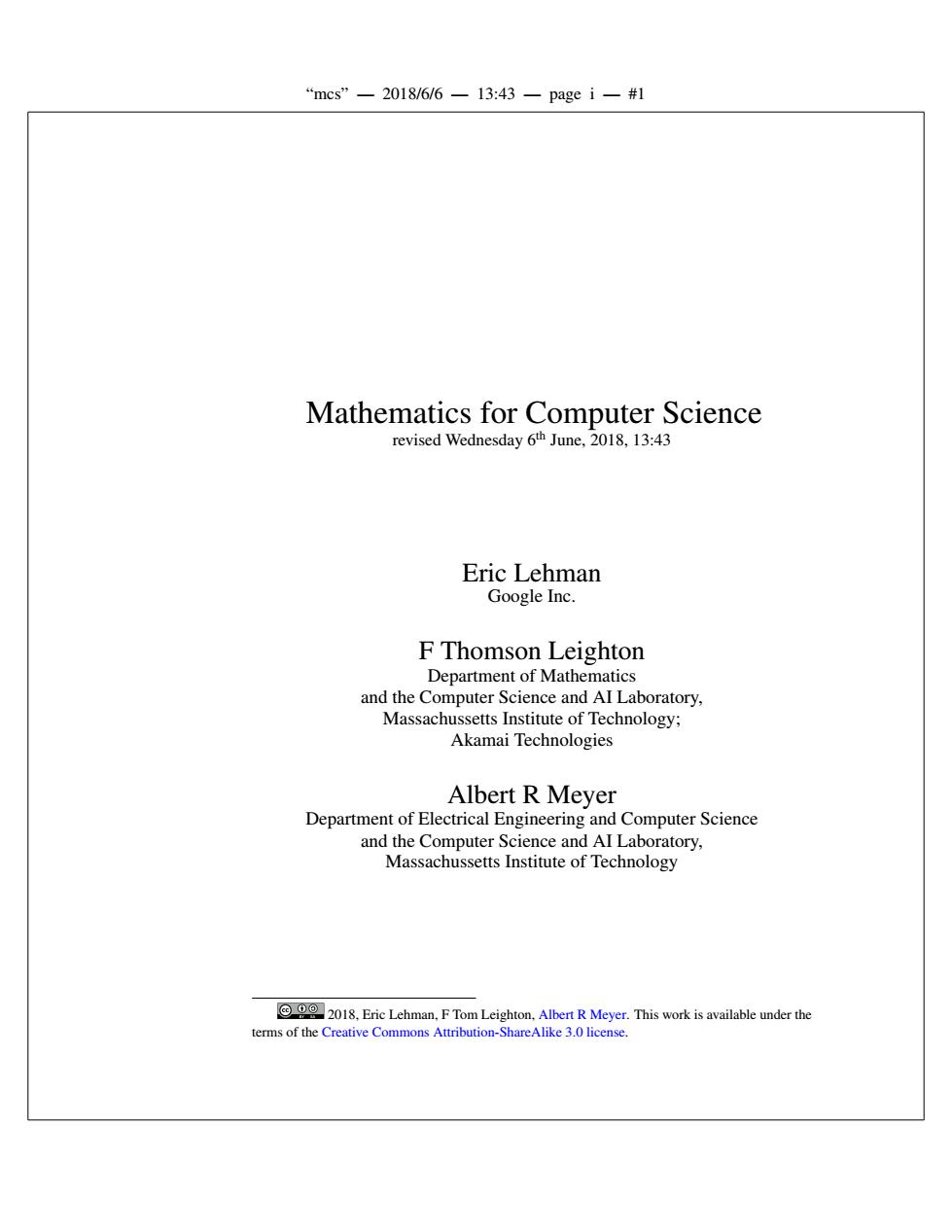
“mcs”一2018/6/6一13:43一page i一#1 Mathematics for Computer Science revised Wednesday 6th June,2018,13:43 Eric Lehman Google Inc. F Thomson Leighton Department of Mathematics and the Computer Science and AI Laboratory, Massachussetts Institute of Technology; Akamai Technologies Albert R Meyer Department of Electrical Engineering and Computer Science and the Computer Science and AI Laboratory, Massachussetts Institute of Technology 2018.Eric Lehman,F Tom Leighton.Albert R Meyer.This work is available under the terms of the Creative Commons Attribution-ShareAlike 3.0 license
“mcs” — 2018/6/6 — 13:43 — page i — #1 Mathematics for Computer Science revised Wednesday 6th June, 2018, 13:43 Eric Lehman Google Inc. F Thomson Leighton Department of Mathematics and the Computer Science and AI Laboratory, Massachussetts Institute of Technology; Akamai Technologies Albert R Meyer Department of Electrical Engineering and Computer Science and the Computer Science and AI Laboratory, Massachussetts Institute of Technology 2018, Eric Lehman, F Tom Leighton, Albert R Meyer. This work is available under the terms of the Creative Commons Attribution-ShareAlike 3.0 license
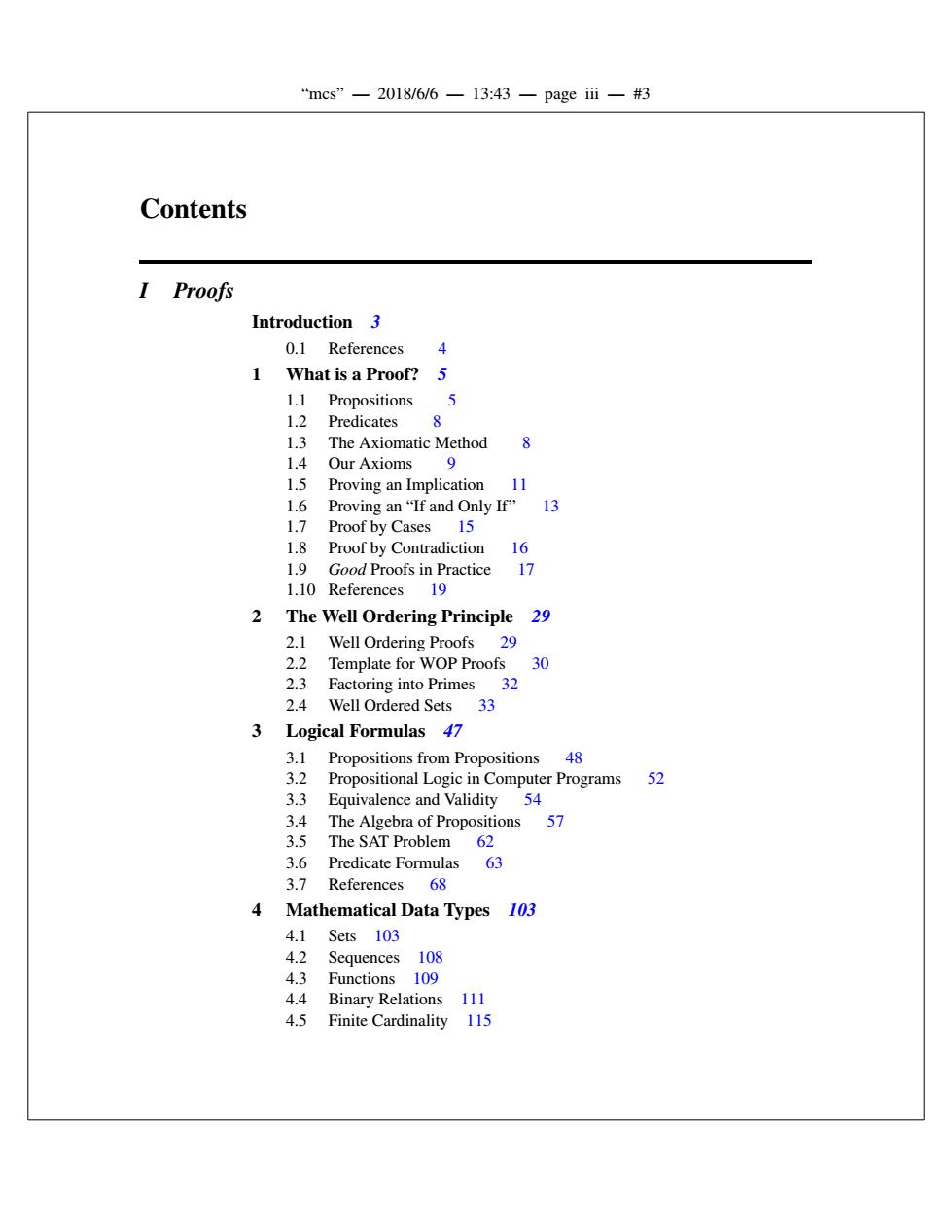
“mcs”一2018/6/6一13:43一page ifⅲi一#3 Contents Proofs Introduction 3 0.1 References 4 1 What is a Proof?5 1.1 Propositions 5 P 1.2 Predicates 1.3 The Axiomatic Method 8 1.4 Our Axioms 9 1.5 Proving an Implication 11 1.6 Proving an“If and Only If'”l3 1.7 Proof by Cases 15 1.8 Proof by Contradiction 16 1.9 Good Proofs in Practice 17 1.10 References 19 2 The Well Ordering Principle 29 2.1 Well Ordering Proofs 29 2.2 Template for WOP Proofs 30 2.3 Factoring into Primes 32 2.4 Well Ordered Sets 33 3 Logical Formulas 47 3.1 Propositions from Propositions 48 3.2 Propositional Logic in Computer Programs 52 3.3 Equivalence and Validity 54 3.4 The Algebra of Propositions 57 3.5 The SAT Problem 62 3.6 Predicate Formulas 63 3.7 References 68 4 Mathematical Data Types 103 4.1Sets103 4.2 Sequences 108 4.3 Functions 109 4.4 Binary Relations 111 4.5 Finite Cardinality 115
“mcs” — 2018/6/6 — 13:43 — page iii — #3 Contents I Proofs Introduction 3 0.1 References 4 1 What is a Proof? 5 1.1 Propositions 5 1.2 Predicates 8 1.3 The Axiomatic Method 8 1.4 Our Axioms 9 1.5 Proving an Implication 11 1.6 Proving an “If and Only If” 13 1.7 Proof by Cases 15 1.8 Proof by Contradiction 16 1.9 Good Proofs in Practice 17 1.10 References 19 2 The Well Ordering Principle 29 2.1 Well Ordering Proofs 29 2.2 Template for WOP Proofs 30 2.3 Factoring into Primes 32 2.4 Well Ordered Sets 33 3 Logical Formulas 47 3.1 Propositions from Propositions 48 3.2 Propositional Logic in Computer Programs 52 3.3 Equivalence and Validity 54 3.4 The Algebra of Propositions 57 3.5 The SAT Problem 62 3.6 Predicate Formulas 63 3.7 References 68 4 Mathematical Data Types 103 4.1 Sets 103 4.2 Sequences 108 4.3 Functions 109 4.4 Binary Relations 111 4.5 Finite Cardinality 115
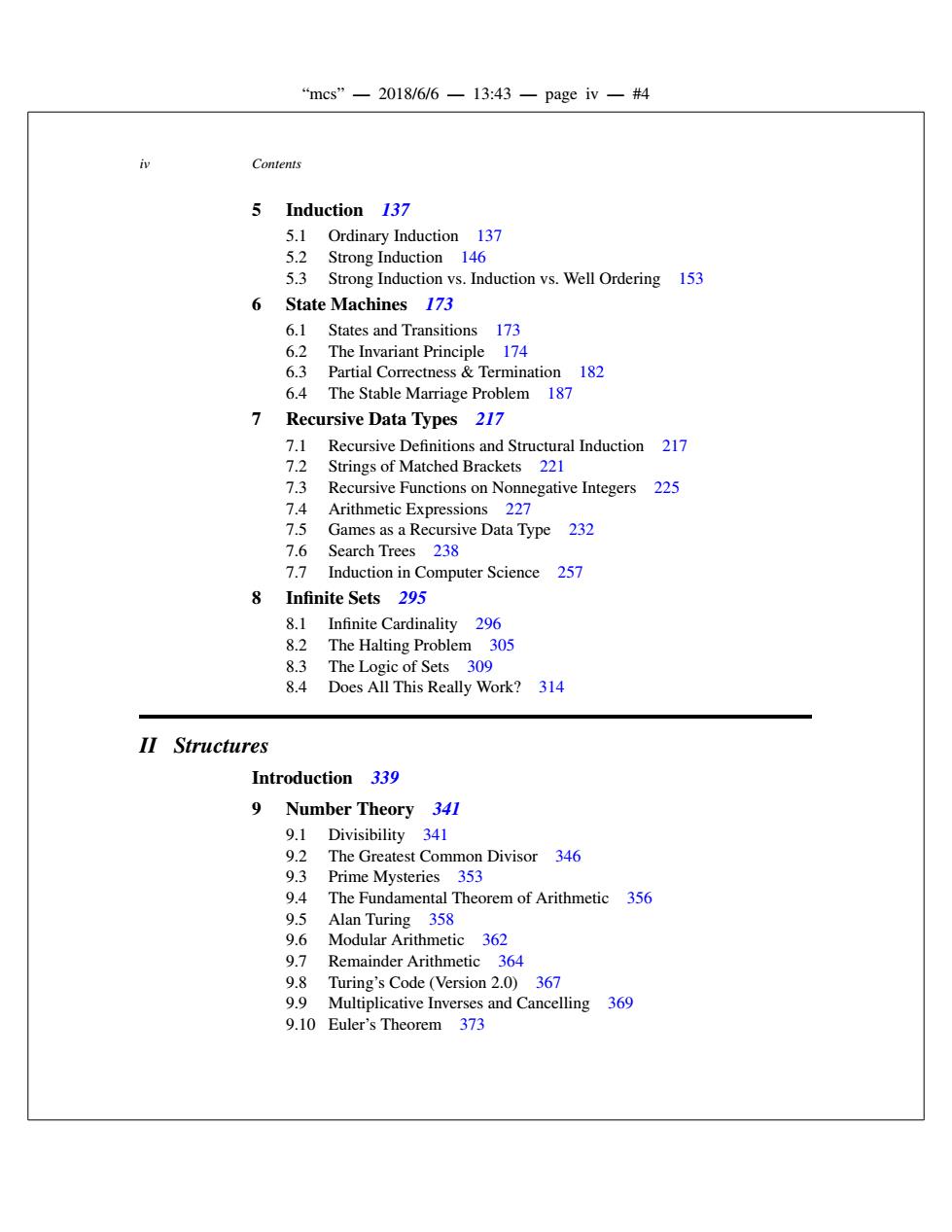
“mcs”一2018/6/6一13:43一page iv一#4 公 Contents 5 Induction 137 5.1 Ordinary Induction 137 5.2 Strong Induction 146 5.3 Strong Induction vs.Induction vs.Well Ordering 153 6 State Machines 173 6.1 States and Transitions 173 6.2 The Invariant Principle 174 6.3 Partial Correctness Termination 182 6.4 The Stable Marriage Problem 187 7 Recursive Data Types 217 7.1 Recursive Definitions and Structural Induction 217 7.2 Strings of Matched Brackets 221 7.3 Recursive Functions on Nonnegative Integers 225 7.4 Arithmetic Expressions 227 7.5 Games as a Recursive Data Type 232 7.6 Search Trees 238 7.7 Induction in Computer Science 257 8 Infinite Sets 295 8.1 Infinite Cardinality 296 8.2 The Halting Problem 305 8.3 The Logic of Sets 309 8.4 Does All This Really Work?314 II Structures Introduction 339 9 Number Theory 341 9.1 Divisibility 341 9.2 The Greatest Common Divisor 346 9.3 Prime Mysteries 353 9.4 The Fundamental Theorem of Arithmetic 356 9.5 Alan Turing 358 9.6 Modular Arithmetic 362 9.7 Remainder Arithmetic 364 9.8 Turing's Code (Version 2.0)367 9.9 Multiplicative Inverses and Cancelling 369 9.10 Euler's Theorem 373
“mcs” — 2018/6/6 — 13:43 — page iv — #4 Contentsiv 5 Induction 137 5.1 Ordinary Induction 137 5.2 Strong Induction 146 5.3 Strong Induction vs. Induction vs. Well Ordering 153 6 State Machines 173 6.1 States and Transitions 173 6.2 The Invariant Principle 174 6.3 Partial Correctness & Termination 182 6.4 The Stable Marriage Problem 187 7 Recursive Data Types 217 7.1 Recursive Definitions and Structural Induction 217 7.2 Strings of Matched Brackets 221 7.3 Recursive Functions on Nonnegative Integers 225 7.4 Arithmetic Expressions 227 7.5 Games as a Recursive Data Type 232 7.6 Search Trees 238 7.7 Induction in Computer Science 257 8 Infinite Sets 295 8.1 Infinite Cardinality 296 8.2 The Halting Problem 305 8.3 The Logic of Sets 309 8.4 Does All This Really Work? 314 II Structures Introduction 339 9 Number Theory 341 9.1 Divisibility 341 9.2 The Greatest Common Divisor 346 9.3 Prime Mysteries 353 9.4 The Fundamental Theorem of Arithmetic 356 9.5 Alan Turing 358 9.6 Modular Arithmetic 362 9.7 Remainder Arithmetic 364 9.8 Turing’s Code (Version 2.0) 367 9.9 Multiplicative Inverses and Cancelling 369 9.10 Euler’s Theorem 373
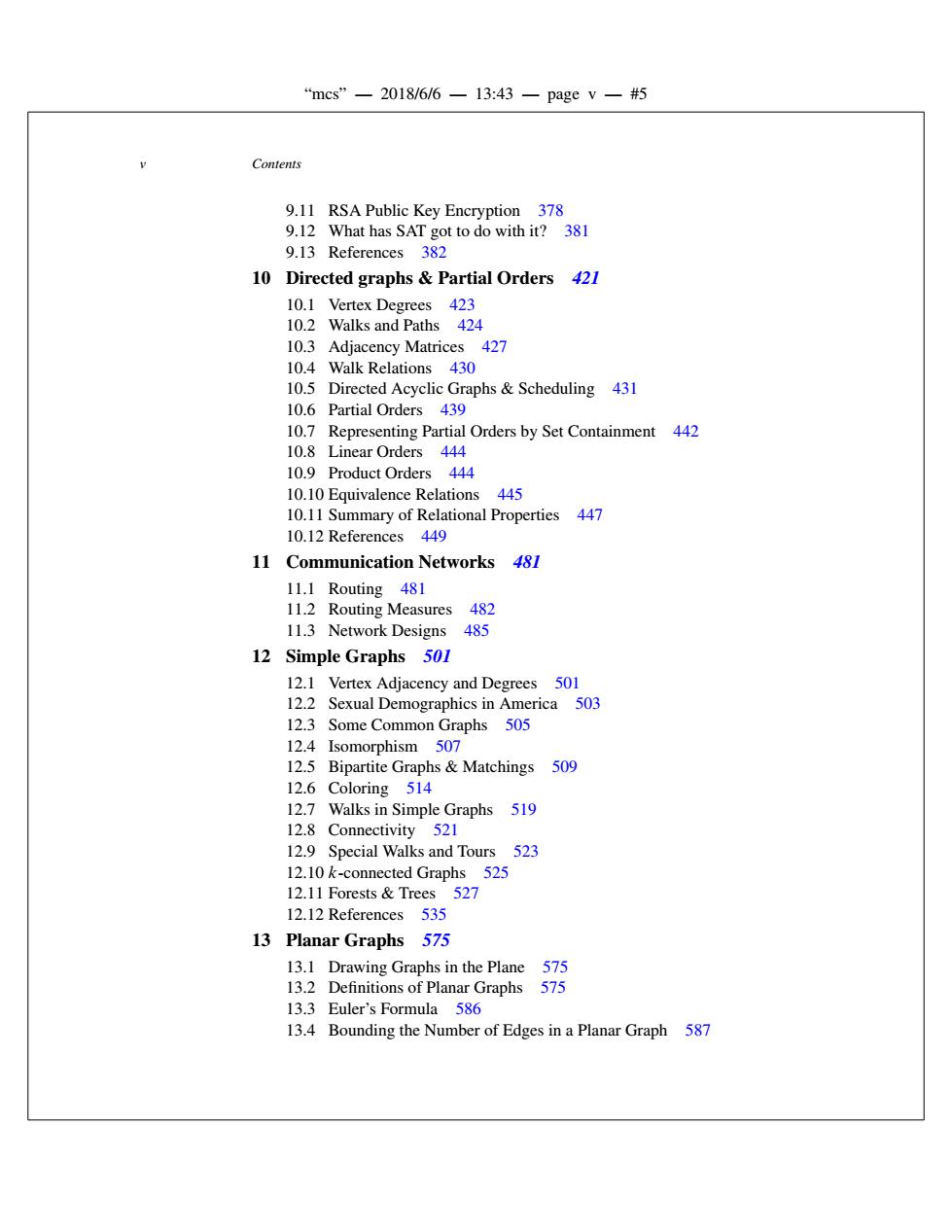
“mcs”一2018/6/6一13:43-page v一#5 Contents 9.11 RSA Public Key Encryption 378 9.12 What has SAT got to do with it?381 9.13 References 382 10 Directed graphs Partial Orders 421 10.1 Vertex Degrees 423 10.2 Walks and Paths 424 10.3 Adjacency Matrices 427 10.4 Walk Relations 430 10.5 Directed Acyclic Graphs Scheduling 431 10.6 Partial Orders 439 10.7 Representing Partial Orders by Set Containment 442 10.8 Linear Orders 444 10.9 Product Orders 444 10.10 Equivalence Relations 445 10.11 Summary of Relational Properties 447 10.12 References 449 11 Communication Networks 481 11.1 Routing 481 11.2 Routing Measures 482 11.3 Network Designs 485 12 Simple Graphs 501 12.1 Vertex Adjacency and Degrees 501 12.2 Sexual Demographics in America 503 12.3 Some Common Graphs 505 12.4 Isomorphism 507 12.5 Bipartite Graphs Matchings 509 12.6 Coloring 514 12.7 Walks in Simple Graphs 519 12.8 Connectivity 521 12.9 Special Walks and Tours 523 12.10 k-connected Graphs 525 12.11 Forests Trees 527 12.12 References 535 13 Planar Graphs 575 13.1 Drawing Graphs in the Plane 575 13.2 Definitions of Planar Graphs 575 13.3 Euler's Formula 586 13.4 Bounding the Number of Edges in a Planar Graph 587
“mcs” — 2018/6/6 — 13:43 — page v — #5 Contentsv 9.11 RSA Public Key Encryption 378 9.12 What has SAT got to do with it? 381 9.13 References 382 10 Directed graphs & Partial Orders 421 10.1 Vertex Degrees 423 10.2 Walks and Paths 424 10.3 Adjacency Matrices 427 10.4 Walk Relations 430 10.5 Directed Acyclic Graphs & Scheduling 431 10.6 Partial Orders 439 10.7 Representing Partial Orders by Set Containment 442 10.8 Linear Orders 444 10.9 Product Orders 444 10.10 Equivalence Relations 445 10.11 Summary of Relational Properties 447 10.12 References 449 11 Communication Networks 481 11.1 Routing 481 11.2 Routing Measures 482 11.3 Network Designs 485 12 Simple Graphs 501 12.1 Vertex Adjacency and Degrees 501 12.2 Sexual Demographics in America 503 12.3 Some Common Graphs 505 12.4 Isomorphism 507 12.5 Bipartite Graphs & Matchings 509 12.6 Coloring 514 12.7 Walks in Simple Graphs 519 12.8 Connectivity 521 12.9 Special Walks and Tours 523 12.10 k-connected Graphs 525 12.11 Forests & Trees 527 12.12 References 535 13 Planar Graphs 575 13.1 Drawing Graphs in the Plane 575 13.2 Definitions of Planar Graphs 575 13.3 Euler’s Formula 586 13.4 Bounding the Number of Edges in a Planar Graph 587
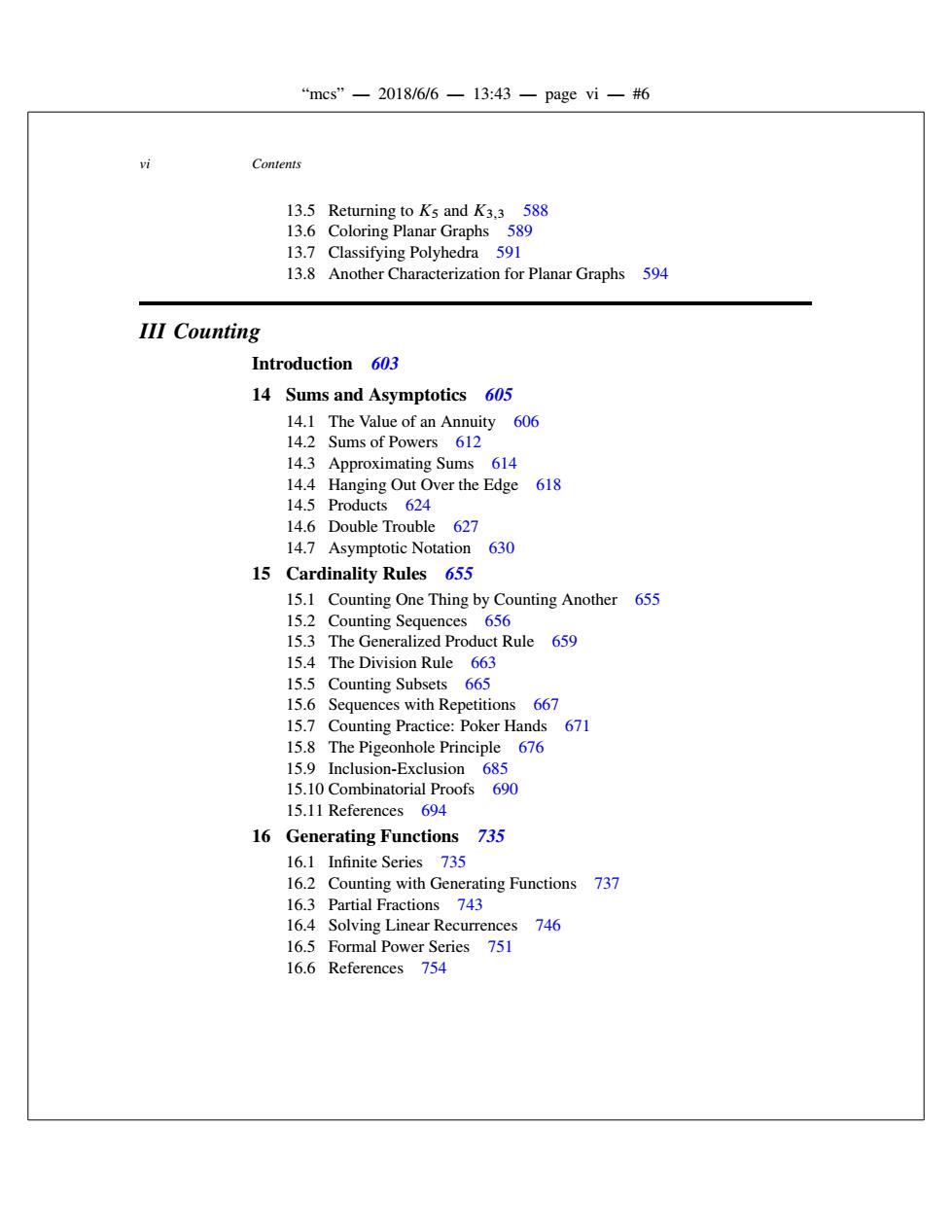
“mcs”一2018/6/6一13:43一page vi-#6 公 Contents 13.5 Returning to Ks and K3.3 588 13.6 Coloring Planar Graphs 589 13.7 Classifying Polyhedra 591 13.8 Another Characterization for Planar Graphs 594 III Counting Introduction 603 14 Sums and Asymptotics 605 14.1 The Value of an Annuity 606 14.2 Sums of Powers 612 14.3 Approximating Sums 614 14.4 Hanging Out Over the Edge 618 14.5 Products 624 14.6 Double Trouble 627 14.7 Asymptotic Notation 630 15 Cardinality Rules 655 15.1 Counting One Thing by Counting Another 655 15.2 Counting Sequences 656 15.3 The Generalized Product Rule 659 15.4 The Division Rule 663 15.5 Counting Subsets 665 15.6 Sequences with Repetitions 667 15.7 Counting Practice:Poker Hands 671 15.8 The Pigeonhole Principle 676 15.9 Inclusion-Exclusion 685 15.10 Combinatorial Proofs 690 15.11 References 694 16 Generating Functions 735 16.1 Infinite Series 735 16.2 Counting with Generating Functions 737 16.3 Partial Fractions 743 16.4 Solving Linear Recurrences 746 16.5 Formal Power Series 751 16.6 References 754
“mcs” — 2018/6/6 — 13:43 — page vi — #6 Contentsvi 13.5 Returning to K5 and K3;3 588 13.6 Coloring Planar Graphs 589 13.7 Classifying Polyhedra 591 13.8 Another Characterization for Planar Graphs 594 III Counting Introduction 603 14 Sums and Asymptotics 605 14.1 The Value of an Annuity 606 14.2 Sums of Powers 612 14.3 Approximating Sums 614 14.4 Hanging Out Over the Edge 618 14.5 Products 624 14.6 Double Trouble 627 14.7 Asymptotic Notation 630 15 Cardinality Rules 655 15.1 Counting One Thing by Counting Another 655 15.2 Counting Sequences 656 15.3 The Generalized Product Rule 659 15.4 The Division Rule 663 15.5 Counting Subsets 665 15.6 Sequences with Repetitions 667 15.7 Counting Practice: Poker Hands 671 15.8 The Pigeonhole Principle 676 15.9 Inclusion-Exclusion 685 15.10 Combinatorial Proofs 690 15.11 References 694 16 Generating Functions 735 16.1 Infinite Series 735 16.2 Counting with Generating Functions 737 16.3 Partial Fractions 743 16.4 Solving Linear Recurrences 746 16.5 Formal Power Series 751 16.6 References 754